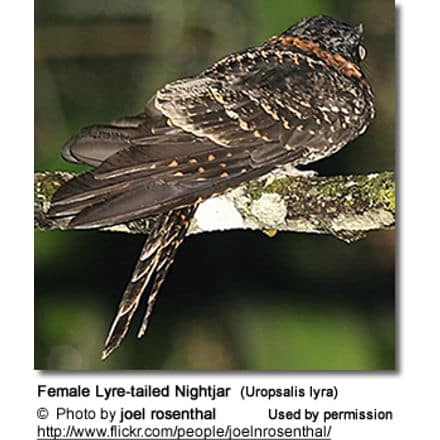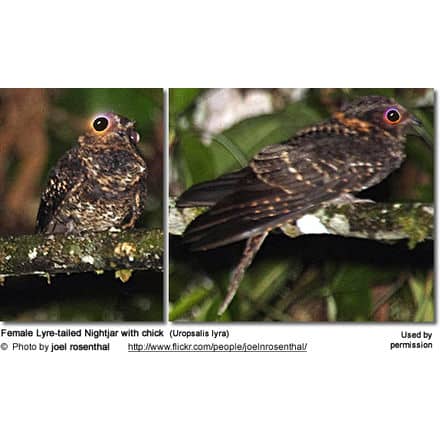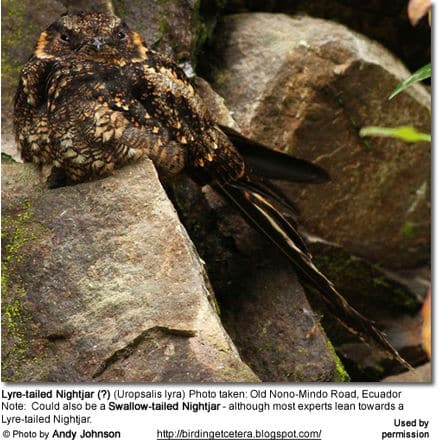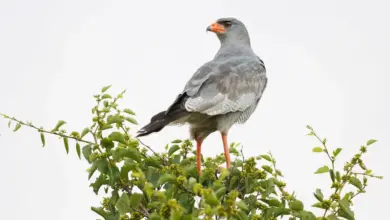Lyre-tailed Nightjars
The Lyre-tailed Nightjars (Uropsalis lyra) is endemic to northwestern South America.
This nightjar is commonly heard within its range, but less often seen – due to its nocturnal habits. Its brown-mottled plumage keeps it well camouflaged during the day when it is also usually hidden away sleeping.
These nightjars have a cryptic appearance that blends perfectly into their habitat. They are very difficult to spot during the daytime when they are usually hidden away while sleeping. They are most easily detected at night when light from car headlights is reflected red from their eyes, as they are sitting on tracks or roads. However, their presence is most often made known by their loud calls given at dusk.
Alternate (Global) Names
Chinese: ????? … Czech: lelek lyroocasý, Lelek lyrový … Danish: Lyrehalenatravn … Dutch: Lierstaartnachtzwaluw … German: Leiernachtschwalbe, Leierschwanz-Nachtschwalbe … Estonian: lüüra-öösorr … Finnish: Lyyrykehrääjä … French: Engoulevent lyre … Italian: Succiacapre coda a lira, Succiacapre codalira … Japanese: tategotoyotaka … Norwegian: Lyrenattravn … Polish: Dziwoletek lirosterny, dziwolotek lirosterny … Russian: ??????????? ???????, ??????????? ??????????? ??????? … Slovak: lelek lýrochvostý … Spanish: Atajacaminos lira, Chotacabras Lira, Dormilón Lira, Guardacaminos Lira … Swedish: Lyrstjärtad nattskärra
Distribution / Habitat
The Lyre-tailed Nightjars is native to South America – where it mostly occurs in eastern parts – from Venezuela south through Colombia, Ecuador, Peru, Bolivia, and Argentina.
It inhabits subtropical or tropical moist montanes.

Subspecies and Distribution
- Uropsalis lyra lyra (Bonaparte, 1850) – Nominate Race
- Range: Western Venezuela, western Colombia, and central Ecuador.
- Uropsalis lyra peruana (Berlepsch and Stolzmann, 1906)
- Range: Central and eastern Peru and west and central Bolivia.
- Uropsalis lyra argentina (Olrog, 1975)
- Range: Northern Argentina (Perico and Calilegua National Park, Jujuy, Argentina) and possibly southern Bolivia.

Description
The plumage is mostly brown-black mottled.
The male Lyre-tailed Nightjars have elongated outermost tail feathers that are said to measure 24 inches (60 cm) or more, accounting for 80 to 90 percent of its total length.
The female’s tail is short.
Nesting / Breeding
The male establishes his territory and sings at night to keep rivals away and at the same time to attract a female. The male Lyre-tailed NIghtjar’s courtship dance has been described as hovering while moving its long streamers in a scissor-like manner.
Nightjars don’t actually construct a nest, as most other bird species do. They simply place the eggs on the ground on open soil covered with dead leaves.
Nesting appears to be timed in such a way that the moon is more than half full at the time they are feeding their young – likely as the additional light during the night facilitates caring for the young and foraging for food.
The female may lay one to two eggs (mostly two) that are whitish or creamy in color, with brown and grey spots or blotches.
During the day, the incubation of the eggs is undertaken by the female, while both parents share the incubation at night. The incubation period is about 19 to 21 days. The hatchlings are covered in feathers down. They are able to make short-distance movements within 24 hours of hatching.
The male stands guard the nest and defends the young. He will hover in place near the nest with his body in a nearly vertical position. The adults communicate with their young via soft clucking sounds to which the chicks respond.
Both parents feed the chicks regurgitated insects. They will continue to brood them until fledging. The chicks take their first flight when they are about 20 to 21 days old.
If conditions are favorable, the female may lay a second clutch close to the first and while she is incubating the new set of eggs, the male continues to care for the young from the first brood.

They have developed several behavioral adaptations to minimize predation:
- Their nocturnal (night) lifestyle reduces the likelihood of being detected by daytime predators. During the daytime, they typically sleep on the ground where they are perfectly camouflaged by their “earthy” colored plumage. They almost always change their roost sites on a daily basis.
- When nesting, they sit quietly on the eggs, minimizing any movements that could get them detected.
- If an intruder does get close to the nest, the parents may try to lead them away by first flushing off the nest and when landing feigning injury as they lead the potential thread away from the nest. While the parent performs this distraction display, the young may scatter and freeze.
- The parent who is not incubating the eggs or brooding the young will roost away from the nesting area.
- They may also move the eggs or young to prevent them from being preyed upon.
- Nightjars avoid voicing when they hear the calls made by predatory nocturnal animals, such as owls.

The Feeding Habits of Nightjars / Nighthawks





